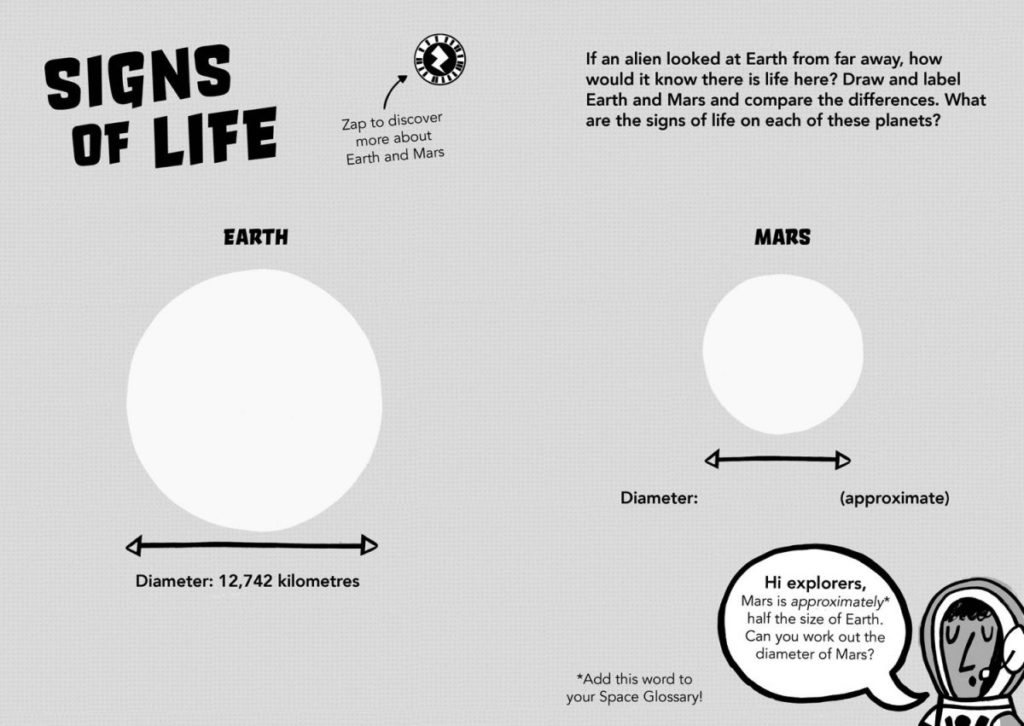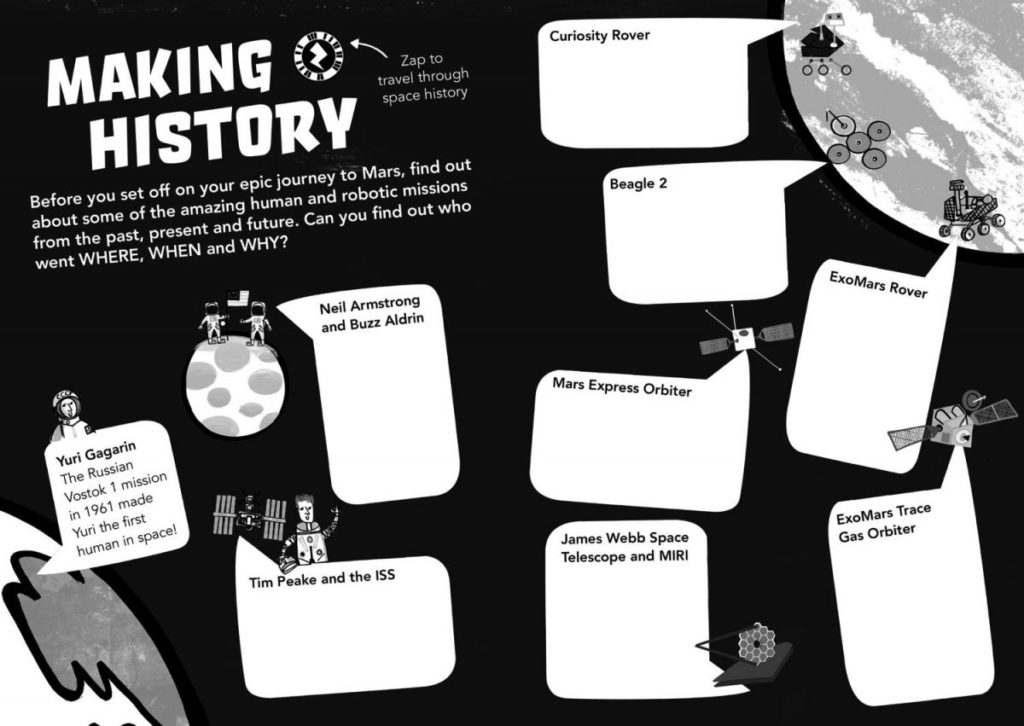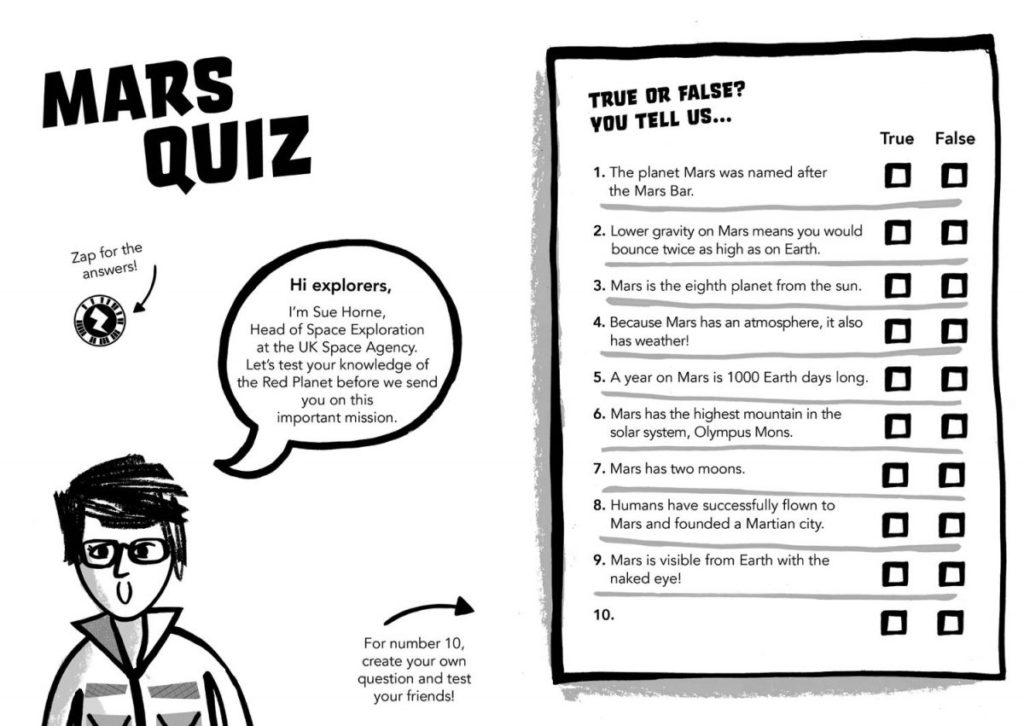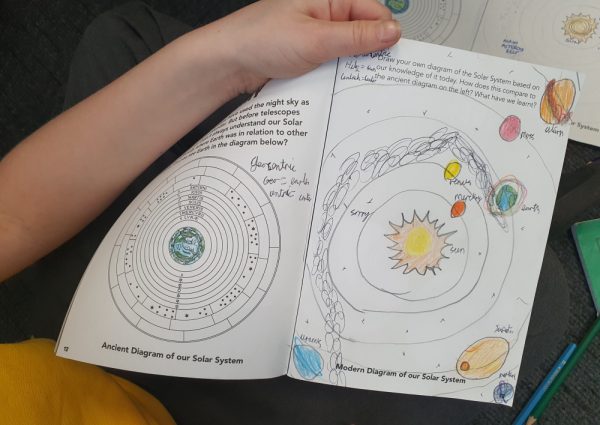You can even use some of these expansion activities as a way to set Mars Diary homework and encourage parent participation.
Here we look at each activity in Chapter One: Life on Mars.
Activity 1.1: Signs of Life

This activity requires students to research and draw Earth and Mars, focusing on what the ‘signs of life’ might be. Comparing Earth with its neighbour Mars and drawing the differences will help students to understand the concept of life as we know it on Earth and what this means in the context of Mars.
Expanding this activity as a written exercise:
Earth vs Mars: Assign each child a planet – either Earth or Mars. After the initial discussion around signs of life on both planets, each child can research their planet and the facts and signs of life on it. After significant research, each child collates their research into a brief presentation (could be a PowerPoint, an A3/A2 poster/non-chronological report, or a larger, annotated version of the original activity). Children can either present their work to the class or have a display corner for the research and presentations on each planet. Run a ballot and have childrens vote as to which planet they would prefer to live on and why.
Alternatively this could be a group exercise where the class or group is split into two teams (Earth and Mars) and each child assigned a research role within the group.
Use the opportunity to involve your school library and gather all the space books into a single display so children can have set library research time.
Useful Links:
- Read about the oldest fossils on Earth
- Mars 101, National Geographic (video)
- Mars Trek, Google Earth for Mars
Activity 1.2: Making History

This activity focuses on the history of space exploration, both human and robotic, and allows students to understand the progress made in terms of space travel over the past 70 years.
Expanding this activity as a written exercise:
Research and Present: Change the focus to scientific communication by asking your pupils to present back on their findings. For Lower Key Stage 2 this could be as simple as preparing or reading out what they have found out. For Upper Key Stage 2, this could be to prepare a brief on the mission, and present this to the class in order to secure votes for their ‘mission’.
Ask pupils to choose one of the moments in space history to write an extended report on it. This could be demonstrated in poster form, or as a diorama with accompanying research in a folder.
Fact Cards: Download and print out the Fact Cards (Zappar content which is available to download on the activity page as an Image Bundle or Powerpoint presentation) and ask children to create their own Fact Cards to add to a class ‘pack’.
Useful Links:
Activity 1.3: Mars Quiz

The Martian space quiz is a fun way to find out more about Mars for students and teachers.
Expanding this activity as a written exercise:
Non Chronological Report: Children can pick a fact of their choosing to research further. This could be given as an extension to the lesson (additional task) or as a follow-up activity at home (home learning). Children create a non-chronological report on their chosen fact/question, applying research skills and use of non-fiction texts to create this report. Language could be formal or informal (depending on need of the class or personal choice) and could contain images and diagrams to support. This would give children a good cross-curricular writing site of application.
The most straight-forward themes to research would be:
- Research why Mars and its moons where given their names by the Ancient Romans.
- Research how high the mountains on Earth are.
- How much higher is Olympus Mons? Draw a to-scale diagram of the different mountains.
- Research all the missions to Mars and find out which ones were successful
Useful Links:
- NASA gallery of Olympus Mons
- Clip about origins and future of Mars’s moons (video)
- Chart of Mars exploration history
Activity 1.4: Letter to Tim

This activity combines several factors – firstly, the incredible inspirational figure of Tim Peake and the way he has managed to engage the imaginations of school children across the UK with space travel. Secondly, it provides an opportunity for students to write creatively but thirdly, it also requires that they do some basic research into the issues involved in interplanetary travel.
This is very clearly a writing activity on its own, but here’s how you could expand on it and push it further:
Use the Zap code to listen to a recorded message from Tim (it is also available to download directly from the Activity page, if you do nothave access to the Zappar app). In the recording, Tim talks about the risks and benefits of space exploration. After this, brainstorm ideas about the costs and benefits of travelling to Mars. If required, at this point, children can independently research the issues surrounding interplanetary travel (resources, temperatures, oxygen, time, cost, training, radiation). Before writing, either in groups or as a class, collate information and models on:
- Good persuasive openers
- Features of a letter
- Formal language
This will help the children to work independently in their writing. Children can then pick which points they want to raise and start to write/structure their persuasive letter. These can be edited and shared at the end.
Ask your class questions to get them thinking broadly about the topic. For example:
- How can we persuade someone to go to Mars?
- What incentives can we provide?
- What features do letters have?
- How will we protect people from the radiation?
- What formal language should we use?
- What would persuade you to go to Mars?
Graffiti Wall: Generate language before starting using a ‘Graffiti Wall’. Using large paper (or flipchart paper) stick an image or word in the middle. This could be images to discuss the issues with space travel, or language to do with persuasive letter writing. Let the children generate ideas and vocabulary for each, and use this as a foundation for their letter writing.
Working in individually or in teams, children could select one persuasive argument and develop it. For example, one could tackle lack of resources, one could tackle radiation etc. Each could then persuade and argue as to why this is not an issue and how they will tackle it, selling their solutions to the problem persuasively. This could then be debated, communicated or videoed (using above apps) for class to collate into an excellent class letter to Tim, or to use this as a foundation for writing their own persuasive letters including all the points.
///
Each activity in the Mars Diary comes with detailed Teaching Notes that provide a wealth of information and ideas on how you can adjust each activity for your classes learning level and how you can expand on each one for maximum cross-curricular learning. Download the Teaching Notes for each activity on the activity’s webpage.
Remember, Mars Diary activities are aimed at children aged 7-11, but can be easily adapted for most primary levels. If you ever have any questions or aren’t sure where to find any of our resources or support materials, just email us! We’re here to help.



